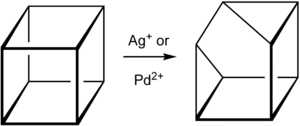 | |
| Names | |
|---|---|
| Preferred IUPAC name Pentacyclooctane | |
| Identifiers | |
| CAS Number | |
| 3D model (JSmol) | |
| ChemSpider | |
| PubChem CID | |
| CompTox Dashboard (EPA) | |
InChI
| |
SMILES
| |
| Properties | |
| Chemical formula | C8H8 |
| Molar mass | 104.152 g·mol |
| Density | 1.578 g/ml |
| Except where otherwise noted, data are given for materials in their standard state (at 25 °C , 100 kPa). Infobox references | |
Cuneane (from Latin cuneus 'wedge') is a saturated hydrocarbon with the formula C8H8 and a 3D structure resembling a wedge, hence the name. Cuneane may be produced from cubane by metal-ion-catalyzed σ-bond rearrangement. Similar reactions are known for homocubane (C9H10) and bishomocubane (C10H12).
Molecular geometry
The carbon atoms in the cuneane molecule form a hexahedron with point group C2v. The cuneane molecule has three kinds of equivalent carbon atoms (A, B, C), which have also been confirmed by NMR. The molecular graph of the carbon skeleton of cuneane is a regular graph with non-equivalent groups of vertices, and so it is a very important test object for different algorithms of mathematical chemistry.
Derivatives
Some cuneane derivatives have liquid crystal properties.
References
- R. Criegee; R. Askani (1968). "Octamethylsemibullvalene". Angewandte Chemie International Edition in English. 7 (7): 537. doi:10.1002/anie.196805371.
- Michael B. Smith; Jerry March (2001). March's Advanced Organic Chemistry (5th ed.). John Wiley & Sons, Inc. p. 1459. ISBN 0-471-58589-0.
- Philip E. Eaton; Luigi Cassar; Jack Halpern (1970). "Silver(I)- and palladium(II)-catalyzed isomerizations of cubane. Synthesis and characterization of cuneane". Journal of the American Chemical Society. 92 (21): 6366–6368. doi:10.1021/ja00724a061.
- Leo A. Paquette; John C. Stowell (1970). "Silver ion catalyzed rearrangements of strained sigma. bonds. Application to the homocubyl and 1,1'-bishomocubyl systems". Journal of the American Chemical Society. 92 (8): 2584–2586. doi:10.1021/ja00711a082.
- W. G. Dauben; M. G. Buzzolini; C. H. Schallhorn; D. L. Whalen; K. J. Palmer (1970). "Thermal and silver ion catalyzed isomerization of the 1,1′-bishomocubane system: preparation of a new C10H10 isomer". Tetrahedron Letters. 11 (10): 787–790. doi:10.1016/S0040-4039(01)97830-X.
- H. Guenther; W. Herrig (1973). "Anwendungen der C-Resonanz-Spektroskopie, X. C,C-Kopplungskonstanten in Methylencycloalkanen". Chemische Berichte. 106 (12): 3938–3950. doi:10.1002/cber.19731061217.
- M.I. Trofimov; E.A. Smolenskii (2000). "Electronegativity of atoms of ring-containing molecules—NMR spectroscopy data correlations: a description within the framework of the topological index approach". Russian Chemical Bulletin. 49 (3): 402. doi:10.1007/BF02494766. S2CID 95809728.
- M.I. Trofimov; E.A. Smolenskii (2005). "Application of the electronegativity indices of organic molecules to tasks of chemical informatics". Russian Chemical Bulletin. 54 (9): 2235. doi:10.1007/s11172-006-0105-6. S2CID 98716956.
- Bényei, Gyula; Jalsovszky, István; Demus, Dietrich; Prasad, Krishna; Rao, Shankar; Vajda, Anikó; Jákli, Antal; Fodor‐Csorba, Katalin (2006). "First liquid crystalline cuneane‐caged derivatives: a structure-property relationship study". Liquid Crystals. 33 (6): 689–696. doi:10.1080/02678290600722940. S2CID 97269476.

